Enhancing Thermal Performance of Thermodynamic Cycle through Zeotropic Mixture Composition Regulation: An Overview
Abstract
1. Introduction
2. Methods of Thermodynamic Cycle Construction
2.1. Conventional Construction Method of Thermodynamic Cycle
2.2. 3D Construction Method of Thermodynamic Cycle
2.3. Superstructure Method of Thermodynamic Cycle
2.4. Intelligent Construction of Thermodynamic Cycle
3. Methods of Zeotropic Mixture Composition Regulation
3.1. Composition Regulation Based on Phase Separation
3.1.1. T-junction
3.1.2. Liquid-Separation Condenser
3.1.3. Distillation Tower
3.2. Composition Regulation Based on Chemical Reaction
4. Conclusions and Prospects
- (1)
- Using a 3D construction method can obtain maximum thermal performance for single thermodynamic process, where the working fluid pair for each process is different and highly relies on the working conditions.
- (2)
- The reliance of a non-artificial experience is the vital parameter to obtain an optimal thermodynamic cycle, with only the intelligence construction method capable of achieving this, while the conventional construction method and superstructure construction method cannot.
- (3)
- The advantages of simple structure and not requiring external energy input of T-junction and liquid-separation condenser contribute to the thermodynamic cycle. However, the range of composition regulation achieved through gravitation force and inertia force is restricted.
- (4)
- Though a wider composition regulation range can be obtained through distillation tower and a hydrate-based method, there is a comprehensive trade-off between the energy input and the improvement in cycle performance.
- (1)
- The combination of 3D construction method and intelligence construction method, where the composition matching for each thermodynamic process is taken as the fundamental principle and the composition regulation process is taken as the basic element in cycle construction, is expected to be a new technical pathway of advance thermodynamic cycle construction.
- (2)
- In composition regulation units, further exploration should be investigated for active composition separation by adding external energy sources in T-junctions, while balancing the trade-off between energy consumption and system performance improvement.
- (3)
- The hydrate-based method has been proven that composition can be regulated through chemical reaction; further exploration is necessary at the theoretical, simulation and experimental level to investigate the fundamental principles and laws of composition regulation as well as the thermal performance when it is coupled within the thermodynamic cycle.
Author Contributions
Funding
Data Availability Statement
Conflicts of Interest
References
- Zhao, J.; Li, Y.; Li, H.; Zhong, Y.; Ma, L.; Li, W. Mid-/low-temperature energy in China. Acta Energiae Solaris Sin. 2022, 43, 250–260. (In Chinese) [Google Scholar]
- National Bureau of Statistics of China. The target of sustained recovery and development of the national economy in 2021 has been achieved. Mach. Ind. Std. Qlty. 2022, 3, 9–12. (In Chinese) [Google Scholar]
- Du, K.; Calautit, J.; Eames, P.; Wu, Y. A state-of-the-art review of the application of phase change materials (PCM) in Mobilized-Thermal Energy Storage (M-TES) for recovering low-temperature industrial waste heat (IWH) for distributed heat supply. Renew. Energy 2021, 168, 1040–1057. [Google Scholar] [CrossRef]
- Firth, A.; Zhang, B.; Yang, A. Quantification of global waste heat and its environmental effects. Appl. Energy 2019, 235, 1314–1334. [Google Scholar] [CrossRef]
- Aboelwafa, O.; Fateen, S.K.; Soliman, A.; Ismail, I.M. A review on solar Rankine cycles: Working fluids, applications, and cycle modifications. Renew. Sustain. Energy Rev. 2018, 82, 868–885. [Google Scholar] [CrossRef]
- Zhao, Y.; Liu, G.; Li, L.; Yang, Q.; Tang, B.; Liu, Y. Expansion devices for organic Rankine cycle (ORC) using in low temperature heat recovery: A review. Energy Convers. Manag. 2019, 199, 111944. [Google Scholar] [CrossRef]
- Shi, L.; Shu, G.; Tian, H.; Deng, S. A review of modified Organic Rankine cycles (ORCs) for internal combustion engine waste heat recovery (ICE-WHR). Renew. Sustain. Energy Rev. 2018, 92, 95–110. [Google Scholar] [CrossRef]
- Park, B.; Usman, M.; Imran, M.; Pesyridis, A. Review of Organic Rankine Cycle experimental data trends. Energy Convers. Manag. 2018, 173, 679–691. [Google Scholar] [CrossRef]
- Landelle, A.; Tauveron, N.; Haberschill, P.; Revellin, R.; Colasson, S. Organic Rankine cycle design and performance comparison based on experimental database. Appl. Energy 2017, 204, 1172–1187. [Google Scholar] [CrossRef]
- Li, J.; Liu, Q.; Duan, Y.; Yang, Z. Performance analysis of organic Rankine cycles using R600/R601a mixtures with liquid-separated condensation. Appl. Energy 2017, 190, 376–389. [Google Scholar] [CrossRef]
- Yan, G.; Cui, C.; Yu, J. Energy and exergy analysis of zeotropic mixture R290/R600a vapor-compression refrigeration cycle with separation condensation. Int. J. Refrig. 2015, 53, 155–162. [Google Scholar] [CrossRef]
- Yang, X.; Zheng, N.; Zhao, L.; Deng, S.; Li, H.; Yu, Z. Analysis of a novel combined power and ejector-refrigeration cycle. Energy Convers. Manag. 2016, 108, 266–274. [Google Scholar] [CrossRef]
- Luo, X.; Huang, R.; Yang, Z.; Chen, J.; Chen, Y. Performance investigation of a novel zeotropic organic Rankine cycle coupling liquid separation condensation and multi-pressure evaporation. Energy Convers. Manag. 2018, 161, 112–127. [Google Scholar] [CrossRef]
- Yaïci, W.; Entchev, E.; Longo, M. Organic Rankine cycle-ejector heat pump hybrid system using low GWP zeotropic mixtures for trigeneration application. Energy Convers. Manag. 2024, 299, 117853. [Google Scholar] [CrossRef]
- Feili, M.; Rostamzadeh, H.; Ghaebi, H. A new high-efficient cooling/power cogeneration system based on a double-flash geothermal power plant and a novel zeotropic bi-evaporator ejector refrigeration cycle. Renew. Energy 2020, 162, 2126–2152. [Google Scholar] [CrossRef]
- Lu, P.; Luo, X.; Wang, J.; Chen, J.; Liang, Y.; Yang, Z.; Wang, C.; Chen, Y. Thermo-economic design, optimization, and evaluation of a novel zeotropic ORC with mixture composition adjustment during operation. Energy Convers. Manag. 2021, 230, 113771. [Google Scholar] [CrossRef]
- Lu, P.; Luo, X.; Wang, J.; Chen, J.; Liang, Y.; Yang, Z.; He, J.; Wang, C.; Chen, Y. Thermodynamic analysis and evaluation of a novel composition adjustable Carnot battery under variable operating scenarios. Energy Convers. Manag. 2022, 269, 116117. [Google Scholar] [CrossRef]
- Xu, W.; Zhao, L.; Deng, S.; Li, S. A preliminary approach to the 3D construction of thermodynamic cycle based on zeotropic working fluids. Chin. Sci. Bull. 2019, 64, 206–214. (In Chinese) [Google Scholar] [CrossRef]
- Zheng, N.; Song, W.; Zhao, L. Theoretical and experimental investigations on the changing regularity of the extreme point of the temperature difference between zeotropic mixtures and heat transfer fluid. Energy 2013, 55, 541–552. [Google Scholar] [CrossRef]
- Stijepovic, M.Z.; Linke, P.; Papadopoulos, A.I.; Grujic, A.S. On the role of working fluid properties in Organic Rankine Cycle performance. Appl. Therm. Eng. 2012, 36, 406–413. [Google Scholar] [CrossRef]
- Xu, W.; Zhang, J.; Zhao, L.; Deng, S.; Zhang, Y. Novel experimental research on the compression process in organic Rankine cycle (ORC). Energy Convers. Manag. 2017, 137, 1–11. [Google Scholar] [CrossRef]
- Giuffrida, A. Modelling the performance of a scroll expander for small organic Rankine cycles when changing the working fluid. Appl. Therm. Eng. 2014, 70, 1040–1049. [Google Scholar] [CrossRef]
- Da Lio, L.; Manente, G.; Lazzaretto, A. Predicting the optimum design of single stage axial expanders in ORC systems: Is there a single efficiency map for different working fluids? Appl. Energy 2016, 167, 44–58. [Google Scholar] [CrossRef]
- Ma, W.; Liu, T.; Li, M. Second-law-based screening of working fluids for medium-low temperature organic Rankine cycles (ORCs): Effects of physical and chemical properties. Energy Procedia 2019, 158, 1406–1411. [Google Scholar] [CrossRef]
- Burugupally, S.P.; Weiss, L.; Depcik, C. The effect of working fluid properties on the performance of a miniature free piston expander for waste heat harvesting. Appl. Therm. Eng. 2019, 151, 431–438. [Google Scholar] [CrossRef]
- Xue, D. Study on Mass Integration for Waste Minimization. Ph.D. Thesis, Dalian University of Technology, Dalian, China, 2001. (In Chinese). [Google Scholar]
- Kermani, M.; Wallerand, A.S.; Kantor, I.D.; Maréchal, F. Generic superstructure synthesis of organic Rankine cycles for waste heat recovery in industrial processes. Appl. Energy 2018, 212, 1203–1225. [Google Scholar] [CrossRef]
- Elsido, C.; Mian, A.; Martelli, E. A systematic methodology for the techno-economic optimization of Organic Rankine Cycles. Energy Procedia 2017, 129, 26–33. [Google Scholar] [CrossRef]
- Lee, U.; Jeon, J.; Han, C.; Lim, Y. Superstructure based techno-economic optimization of the organic rankine cycle using LNG cryogenic energy. Energy 2017, 137, 83–94. [Google Scholar] [CrossRef]
- Yu, H.; Eason, J.; Biegler, L.T.; Feng, X. Process integration and superstructure optimization of Organic Rankine Cycles (ORCs) with heat exchanger network synthesis. Comput. Chem. Eng. 2017, 107, 257–270. [Google Scholar] [CrossRef]
- Bao, J.; Zhang, R.; Lin, Y.; Zhang, N.; Zhang, X.; He, G. Simultaneous optimization of system structure and working fluid for the three-stage condensation Rankine cycle utilizing LNG cold energy. Appl. Therm. Eng. 2018, 140, 120–130. [Google Scholar] [CrossRef]
- Yuan, T.; Song, C.; Zhang, R.; Zhang, X.; Zhang, N.; Bao, J. Energy and Economic Optimization of the Multistage Condensation Rankine Cycle That Utilizes LNG Cold Energy: Considerations on Working Fluids and Cycle Configurations. ACS Sustain. Chem. Eng. 2019, 7, 13505–13516. [Google Scholar] [CrossRef]
- Schilling, J.; Horend, C.; Bardow, A. Integrating superstructure-based design of molecules, processes, and flowsheets. AIChE J. 2020, 66, e16903. [Google Scholar] [CrossRef]
- Elsido, C.; Martelli, E.; Grossmann, I.E. Multiperiod optimization of heat exchanger networks with integrated thermodynamic cycles and thermal storages. Comput. Chem. Eng. 2021, 149, 107293. [Google Scholar] [CrossRef]
- Watanapanich, S.; Li, S.; Lee, J. Optimal integration of organic Rankine cycles into process heat exchanger networks: A simultaneous approach. Energy Convers. Manag. 2022, 260, 115604. [Google Scholar] [CrossRef]
- Huster, W.R.; Schweidtmann, A.M.; Lüthje, J.T.; Mitsos, A. Deterministic global superstructure-based optimization of an organic Rankine cycle. Comput. Chem. Eng. 2020, 141, 106996. [Google Scholar] [CrossRef]
- Liang, Z.; Liang, Y.; Luo, X.; Chen, J.; Yang, Z.; Wang, C.; Chen, Y. Superstructure-based mixed-integer nonlinear programming framework for hybrid heat sources driven organic Rankine cycle optimization. Appl. Energy 2022, 307, 118277. [Google Scholar] [CrossRef]
- Wallerand, A.S.; Kermani, M.; Kantor, I.; Maréchal, F. General Superstructure Synthesis and Bi-level Solution Strategy for Industrial Heat Pumping. In Proceedings of the 27th European Symposium on Computer Aided Process Engineering, Barcelona, Spain, 1–5 October 2017. [Google Scholar]
- Wallerand, A.S.; Kermani, M.; Kantor, I.; Maréchal, F. Optimal heat pump integration in industrial processes. Appl. Energy 2018, 219, 68–92. [Google Scholar] [CrossRef]
- Yang, C.; Zhang, X.; Zhang, N.; He, G.; Bao, J. How to identify trade-off of thermodynamic and economic performance of the S-CO2 cycle caused by the cycle structures? Energy Convers. Manag. 2022, 266, 115817. [Google Scholar] [CrossRef]
- Yang, C.; Deng, Y.; Zhang, N.; Zhang, X.; He, G.; Bao, J. Optimal structure design of supercritical CO2 power cycle for gas turbine waste heat recovery: A superstructure method. Appl. Therm. Eng. 2021, 198, 117515. [Google Scholar] [CrossRef]
- Toffolo, A. A synthesis/design optimization algorithm for Rankine cycle based energy systems. Energy 2014, 66, 115–127. [Google Scholar] [CrossRef]
- Toffolo, A.; Rech, S.; Lazzaretto, A. Combination of elementary process to form a general energy system configuration. In Proceedings of the ASME 2017 International Mechanical Engineering Congress and Exposition IMECE2017, Tampa, FL, USA, 3–9 November 2017. [Google Scholar]
- Lazzaretto, A.; Manente, G.; Toffolo, A. A general methodology for the synthesis of energy system configurations beyond superstructures. Energy 2018, 147, 924–949. [Google Scholar] [CrossRef]
- Toffolo, A.; Rech, S.; Lazzaretto, A. Generation of Complex Energy Systems by Combination of Elementary Processes. J. Energy Resour. Technol. 2018, 140, 112005. [Google Scholar] [CrossRef]
- Lin, S.; Zhao, L.; Deng, S.; Zhao, D.; Wang, W.; Chen, M. Intelligent collaborative attainment of structure configuration and fluid selection for the Organic Rankine cycle. Appl. Energy 2020, 264, 114743. [Google Scholar] [CrossRef]
- Liang, Z.; Liang, Y.; Luo, X.; Chen, J.; Yang, Z.; Wang, C.; Chen, Y. Synthesis and simultaneous optimization of multi-heat source multi-pressure evaporation organic Rankine cycle with mixed working fluid. Energy Convers. Manag. 2022, 251, 114930. [Google Scholar] [CrossRef]
- Seki, K.; Takeshita, K.; Amano, Y. Development of Complex Energy Systems with Absorption Technology by Combining Elementary Processes. Energies 2019, 12, 495. [Google Scholar] [CrossRef]
- Volpato, G.; Rech, S.; Lazzaretto, A.; Roumpedakis, T.C.; Karellas, S.; Frangopoulos, C.A. Conceptual development and optimization of the main absorption systems configurations. Renew. Energy 2022, 182, 685–701. [Google Scholar] [CrossRef]
- Ito, W.; Takeshita, K.; Amano, Y. Demonstration of the revised procedure to explore configurations for an arbitrary absorption cycle based on the cycle simplicity index. Energy 2021, 235, 121172. [Google Scholar] [CrossRef]
- Carraro, G.; Danieli, P.; Lazzaretto, A.; Boatto, T. A common thread in the evolution of the configurations of supercritical CO2 power systems for waste heat recovery. Energy Convers. Manag. 2021, 237, 114031. [Google Scholar] [CrossRef]
- Liang, Y.; Hui, C.W.; Luo, X.; Chen, J.; Yang, Z.; Chen, Y. A general mixed-integer programming framework for efficient modeling, integration and optimization of thermodynamic cycle-based energy systems. Energy Convers. Manag. 2021, 250, 114905. [Google Scholar] [CrossRef]
- Yang, B.; Su, W.; Deng, S.; Zhao, L.; Lu, P. State-of-art of impacting T-junction: Phase separation, constituent separation and applications. Int. J. Heat Mass Transf. 2020, 148, 119067. [Google Scholar] [CrossRef]
- Yang, B.; Su, W.; Deng, S.; Zhao, L.; Lu, P. State-of-art of branching T-junction: Experiments, modeling, developing prospects and applications. Exp. Therm. Fluid. Sci. 2019, 109, 109895. [Google Scholar] [CrossRef]
- Zheng, N.; Hwang, Y.; Zhao, L.; Deng, S. Experimental study on the distribution of constituents of binary zeotropic mixtures in vertical impacting T-junction. Int. J. Heat Mass Transf. 2016, 97, 242–252. [Google Scholar] [CrossRef]
- Su, W.; Hwang, Y.; Zheng, N.; Deng, S.; Zhao, L. Experimental study on the constituent separation performance of binary zeotropic mixtures in horizontal branch T-junctions. Int. J. Heat Mass Transf. 2018, 127, 76–87. [Google Scholar] [CrossRef]
- Lu, P.; Deng, S.; Yang, B.; Zhao, L. Numerical simulation on constituents separation of R134a/R600a in a horizontal T-junction. Int. J. Refrig. 2020, 115, 148–157. [Google Scholar] [CrossRef]
- Su, D.; Zhao, L.; Zhao, R.; Bai, M.; Wang, Q.; Zhu, Y. Numerical simulation on constituent separation and mass transfer of binary zeotropic mixtures in a branching T-junction. Int. J. Refrig. 2022, 135, 198–207. [Google Scholar] [CrossRef]
- Fu, J.; Liu, Z.; Yang, X.; Jin, S.; Ye, J. Experimental research on the separation performance of a compound T-junction for two-phase zeotropic mixtures. Exp. Therm. Fluid Sci. 2023, 147, 110951. [Google Scholar] [CrossRef]
- Su, D.; Zhao, R.; Zhao, L.; Wang, Q.; Bai, M.; Deng, S. Separation mechanism of T-junction in thermodynamic systems: A review and case verification. Appl. Therm. Eng. 2022, 217, 119267. [Google Scholar] [CrossRef]
- Yang, B.; Deng, S.; Su, W.; Zhao, L.; Wang, D. Experimental investigation on phase separation comparison between single and double T-junctions. Exp. Therm. Fluid Sci. 2020, 118, 110171. [Google Scholar] [CrossRef]
- Bai, M.J.; Zhao, R.K.; Lu, P.; Yang, B.; Li, Z.; Zhang, Y. Simulation study on phase separation and pressure distribution of refrigerant in horizontal double T-junctions. Int. J. Refrig. 2021, 126, 88–98. [Google Scholar] [CrossRef]
- Peng, X.; Wu, D.; Zhang, Y. Applications and principle of high performance condensers. Chem. Ind. Eng. Prog. 2007, 26, 97–104. (In Chinese) [Google Scholar]
- Huang, K.; Li, J.; Chen, J.; Chen, Y.; Luo, X.; Liang, Y.; He, J.; Yang, Z. Explorations of multi-pass-orifice header in the liquid-separation condenser by using CFD simulation. Int. J. Heat Mass Transf. 2023, 200, 123482. [Google Scholar] [CrossRef]
- Li, Y.; Luo, X.; Wang, Z.; Yang, Z.; Chen, J.; Liang, Y.; Wang, C.; Chen, Y. Numerical simulation on the header-orifice structure-based liquid-vapor separator used in liquid-separation condenser. Chem. Eng. Sci. 2021, 235, 116475. [Google Scholar] [CrossRef]
- Chen, X.; Chen, Y.; Deng, L.; Mo, S.; Zhang, H. Experimental verification of a condenser with liquid-vapor separation in an air conditioning system. Appl. Therm. Eng. 2013, 51, 48–54. [Google Scholar] [CrossRef]
- Chen, J.; Ding, R.; Li, Y.; Lin, X.; Chen, Y.; Luo, X.; Yang, Z. Application of a vapor-liquid separation heat exchanger to the air conditioning system at cooling and heating modes. Int. J. Refrig. 2019, 100, 27–36. [Google Scholar] [CrossRef]
- Li, Y.; Chen, J.; Lin, X.; Yang, Z.; Chen, Y.; Luo, X. Quantification on the Effects of Liquid-Vapor Separation in Air-Conditioning System by using Advanced Exergy Analysis. J. Therm. Sci. 2020, 29, 597–608. [Google Scholar] [CrossRef]
- Luo, X.; Yi, Z.; Zhang, B.; Mo, S.; Wang, C.; Song, M.; Chen, Y. Mathematical modelling and optimization of the liquid separation condenser used in organic Rankine cycle. Appl. Energy 2017, 185, 1309–1323. [Google Scholar] [CrossRef]
- Chen, J.; Chen, L.; Lin, X.; Chen, Y.; Luo, X.; Yang, Z.; Liang, Y. Performance of heat pump water heater (HPWH) with and without liquid-separation: Detailed experimental comparisons. Appl. Therm. Eng. 2020, 179, 115713. [Google Scholar] [CrossRef]
- Li, J.; Liu, Q.; Ge, Z.; Duan, Y.; Yang, Z.; Di, J. Optimized liquid-separated thermodynamic states for working fluids of organic Rankine cycles with liquid-separated condensation. Energy 2017, 141, 652–660. [Google Scholar] [CrossRef]
- Li, J.; Yang, Z.; Hu, S.; Yang, F.; Duan, Y. Thermo-economic performance improvement of butane/isopentane mixtures in organic Rankine cycles by liquid-separated condensation method. Appl. Therm. Eng. 2020, 181, 115941. [Google Scholar] [CrossRef]
- Huang, Y.; Chen, J.; Chen, Y.; Luo, X.; Liang, Y.; He, J.; Yang, Z. Performance explorations of an organic Rankine cycle featured with separating and mixing composition of zeotropic mixture. Energy 2022, 257, 124535. [Google Scholar] [CrossRef]
- Chen, C.; Huang, R.; Luo, X.; Chen, J.; Yang, Z.; Chen, Y. Conceptual design and thermodynamic optimization of a novel composition tunable zeotropic organic Rankine cycle. Energy Procedia 2019, 158, 2019–2024. [Google Scholar] [CrossRef]
- Luo, X.; Liang, Z.; Guo, G.; Wang, C.; Chen, Y.; Ponce-Ortega, J.M.; El-Halwagi, M.M. Thermo-economic analysis and optimization of a zoetropic fluid organic Rankine cycle with liquid-vapor separation during condensation. Energy Convers. Manag. 2017, 148, 517–532. [Google Scholar] [CrossRef]
- Lu, P.; Wang, J.; Lin, Y.; Luo, X.; Liang, Y.; Chen, J.; Yang, Z.; Chen, Y. Experimental investigation of a zeotropic organic Rankine cycle system with liquid-separation condensation for composition adjustment. Energy Convers. Manag. 2023, 293, 117540. [Google Scholar] [CrossRef]
- Sun, X.; Shi, L.; Tian, H.; Wang, X.; Zhang, Y.; Shu, G. A novel composition tunable combined cooling and power cycle using CO2-based binary zeotropic mixture. Energy Convers. Manag. 2021, 244, 114419. [Google Scholar] [CrossRef]
- Chen, C.; Li, N.; Mu, H.; Song, Y.; Zhao, X. Thermodynamic Optimization of a Composition-Tunable ZeotropicORC Using LNG Cold Energy as a Heat Sink. ACS Sustain. Chem. Eng. 2022, 10, 4980–4993. [Google Scholar] [CrossRef]
- Pang, X.; Ge, Z.; Xie, Z.; Xu, J.; Xie, J.; Wang, Y.; Tang, C.; Zhao, W.; Wang, K. Performance analysis of organic flash cycle using R600a/R601a mixtures with liquid-separation condensation. Proc. CSEE 2022, 42, 2615–2623. [Google Scholar]
- Zhu, Y.; Yin, Y. Multi-criteria refrigerant screening and performance optimization comparison of a basic and composition-adjustable dual cooling source system. Appl. Therm. Eng. 2024, 239, 122154. [Google Scholar] [CrossRef]
- Zhu, Y.; Wang, Y.; Yin, Y. Performance analysis of a double cooling source system featured by composition-tuning of zeotropic mixture R32/R236fa. Appl. Therm. Eng. 2023, 224, 120097. [Google Scholar] [CrossRef]
- Collings, P.; Yu, Z.; Wang, E. A dynamic organic Rankine cycle using a zeotropic mixture as the working fluid with composition tuning to match changing ambient conditions. Appl. Energy 2016, 171, 581–591. [Google Scholar] [CrossRef]
- Liu, C.; Gao, T. Off-design performance analysis of basic ORC, ORC using zeotropic mixtures and composition-adjustable ORC under optimal control strategy. Energy 2019, 171, 95–108. [Google Scholar] [CrossRef]
- Kim, M.; Kim, M.S.; Kim, Y. Experimental study on the performance of a heat pump system with refrigerant mixtures’ composition change. Energy 2004, 29, 1053–1068. [Google Scholar] [CrossRef]
- Zhang, Y.; Deng, S.; Zhao, L.; Nie, X.; Xu, W.; He, J. Exploring a potential application of hydrate separation for composition adjustable combined cooling and power system. Appl. Energy 2020, 268, 115064. [Google Scholar] [CrossRef]
- Lai, X.; Zhao, L.; Nie, X.; Zhang, Y.; Zhang, Q. Hydrate-based composition separation of R32/R1234yf mixed working fluids applied in composition-adjustable organic Rankine cycle. Energy 2023, 284, 129259. [Google Scholar] [CrossRef]
- Zhang, Y.; Zhao, R.; Nie, X.; Deng, S.; Xu, W.; Zhu, Y.; Zhao, L. Hydrate-based gas separation for working fluid mixtures: Application to composition-adjustable organic Rankine cycle. Chem. Eng. J. 2022, 434, 134626. [Google Scholar] [CrossRef]
- Xu, W.; Deng, S.; Zhao, L.; Zhang, Y.; Li, S. Performance analysis on novel thermodynamic cycle under the guidance of 3D construction method. Appl. Energy 2019, 250, 478–492. [Google Scholar] [CrossRef]



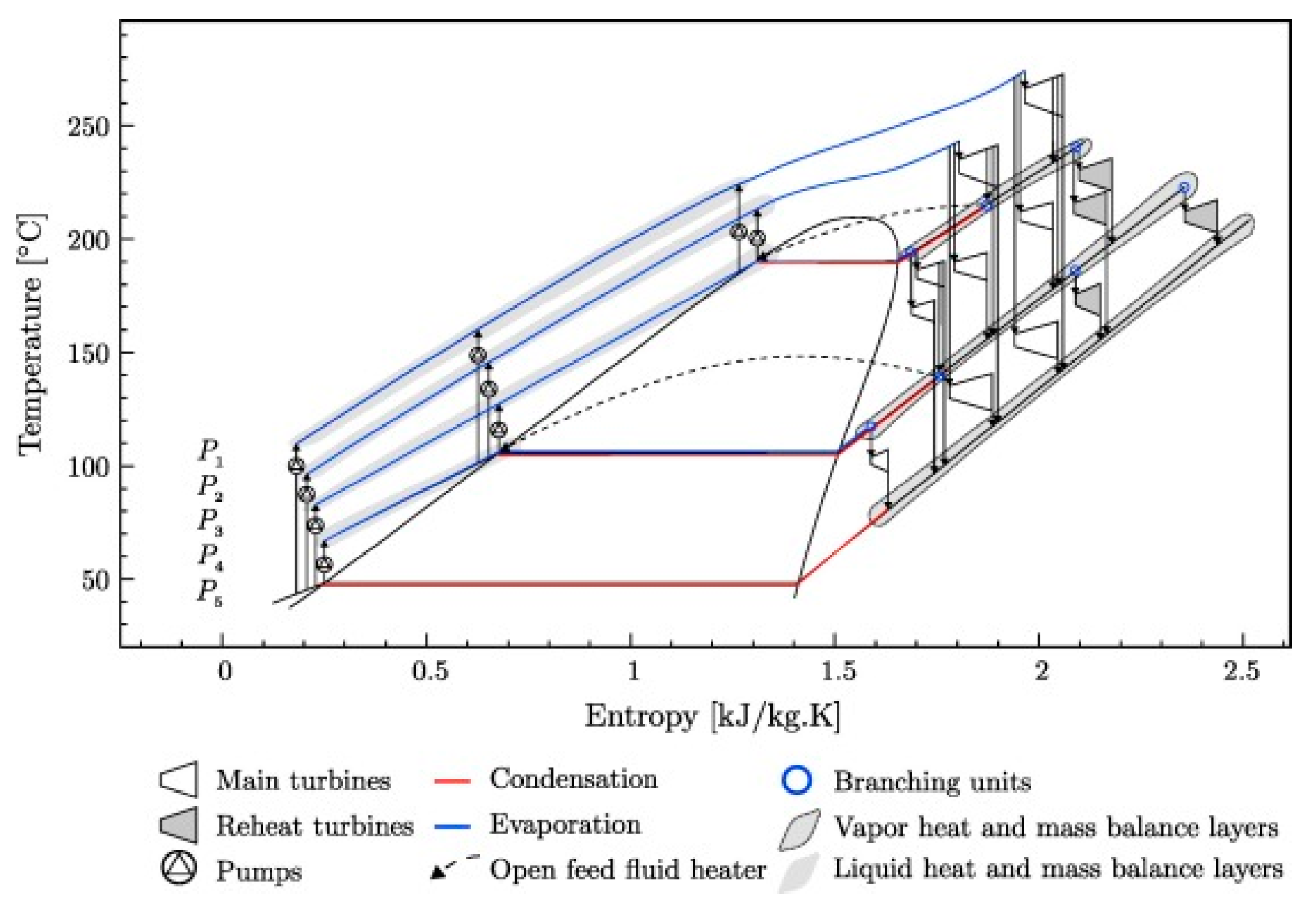
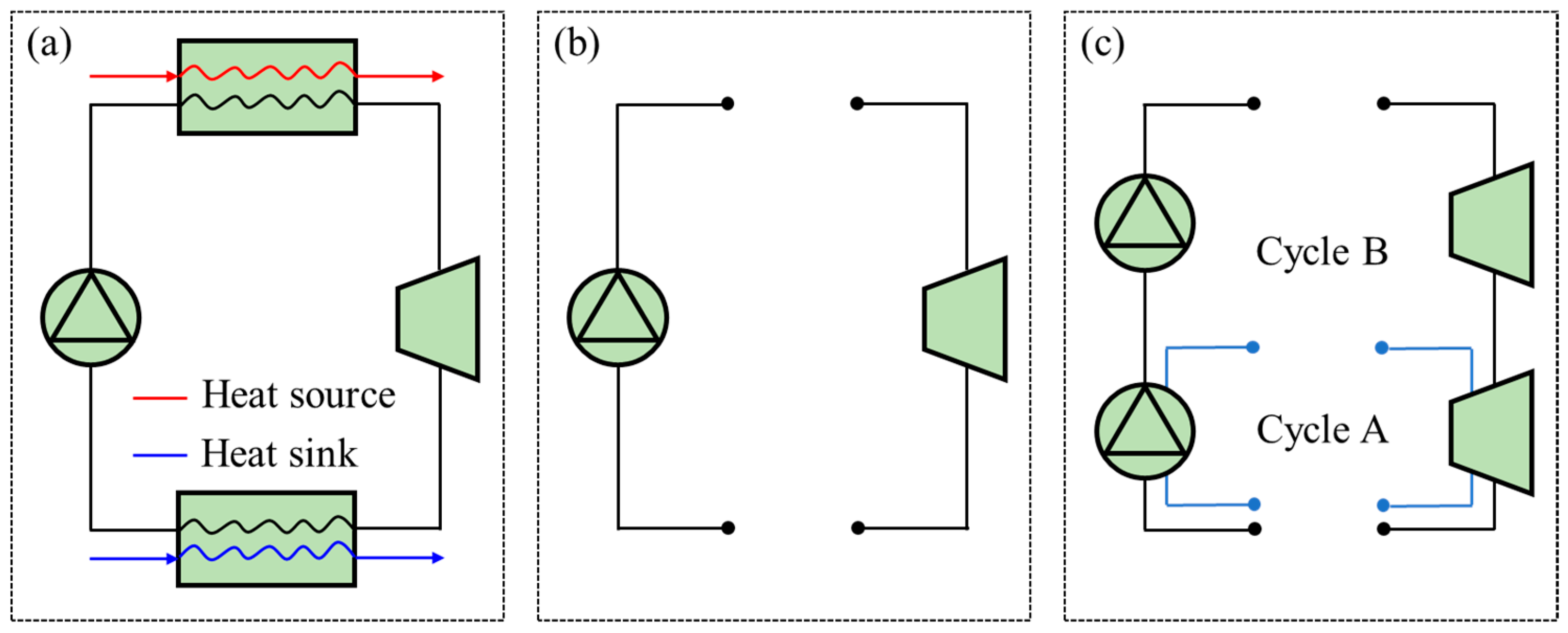
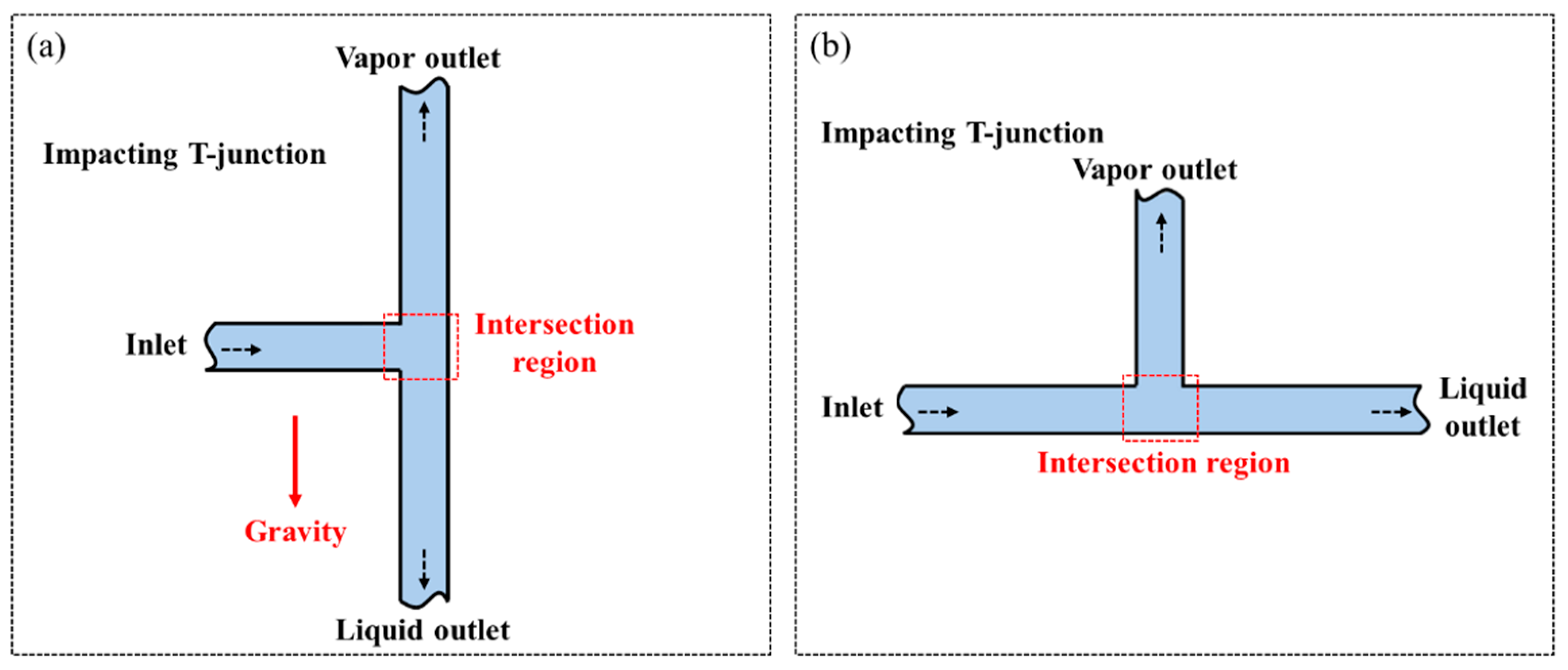

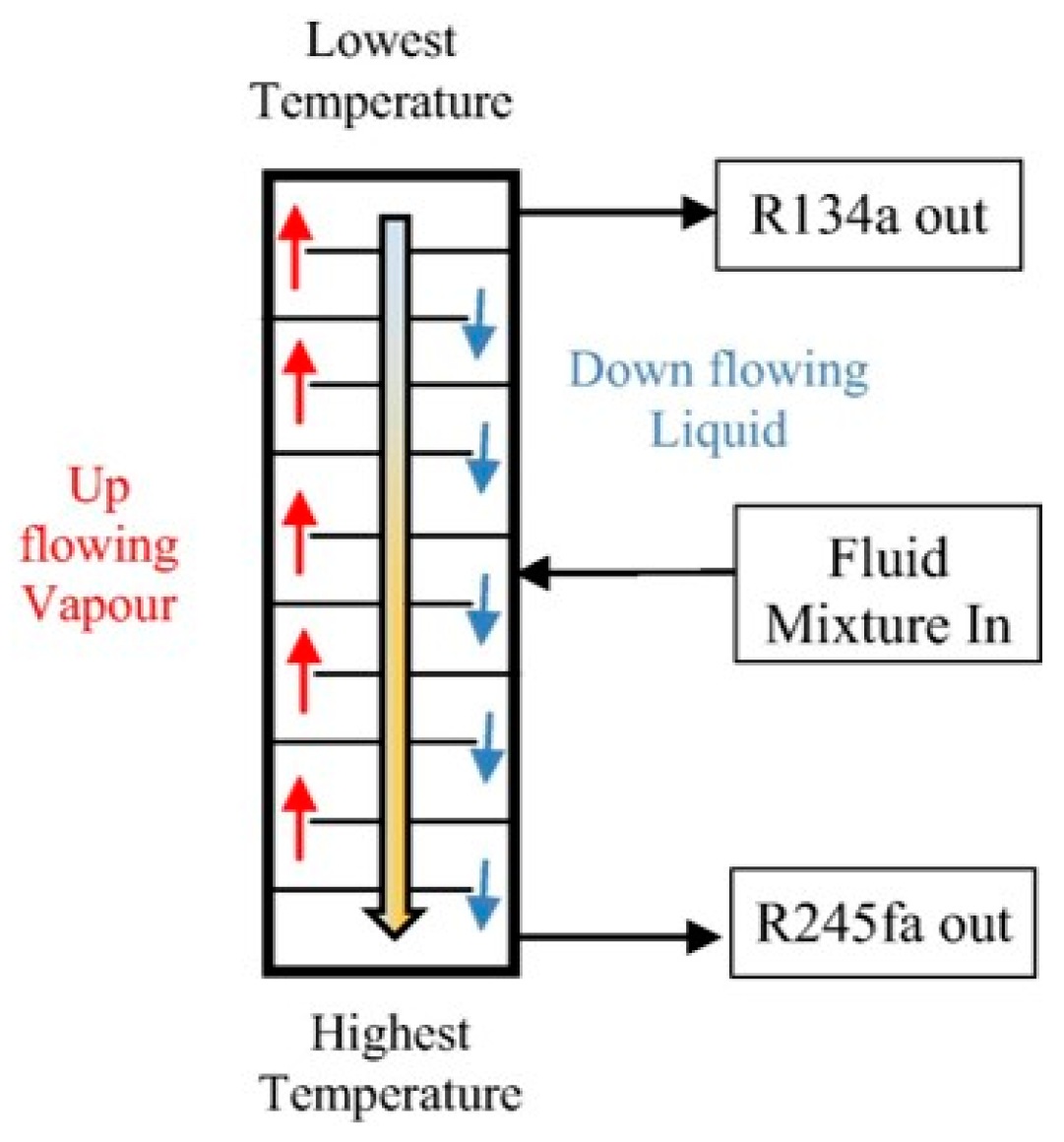
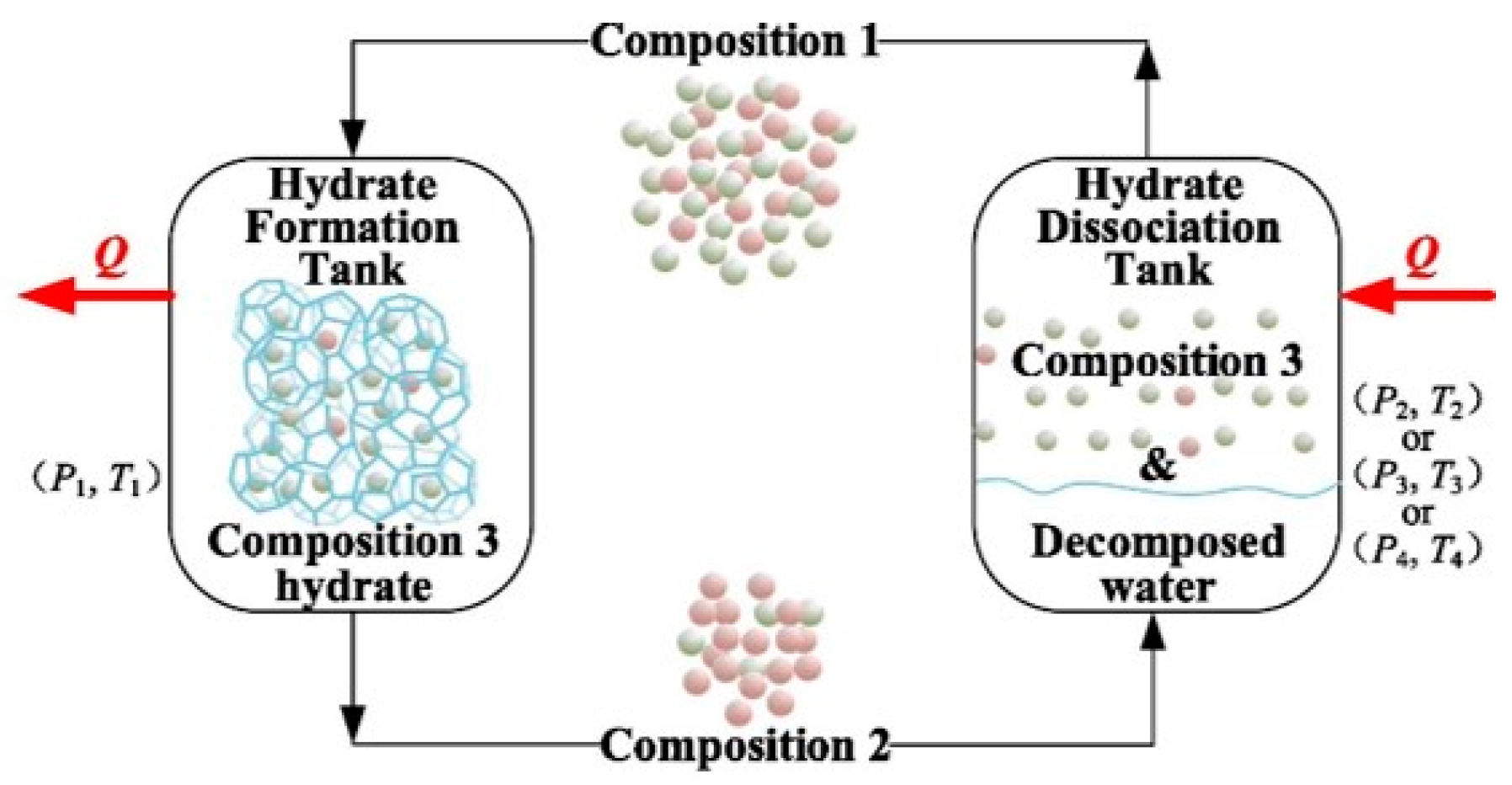

| Ref. | Thermodynamic Process | Selecting Parameters of Working Fluid | Main Findings |
|---|---|---|---|
| [19] | heat transfer | σ | Proposed the statistical parameter to guide the selection of working fluid in the heat transfer process. |
| [20] | compression | vslp | Working fluid with lower saturated liquid molar volume will enhance the performance of the compression process. |
| expansion | αV, M, cp,ig | Working fluids with high compressibility factor, molecular weight, and ideal gas specific heat at constant pressure will improve the performance of the expansion process. | |
| [21] | compression | αV, ρ, cp | The lower the αV/ρcp of the working fluid, the higher the efficiency of the compression process. |
| [22] | expansion | - | The scroll expander numerical model with working fluid properties is established, and the optimize working fluid also proposed. |
| [23] | expansion | ηexp = f(π, ξ, τ, S, V, w) | The expansion efficiency including working fluid properties is proposed. |
| [24] | expansion | Tcri, cp,ig, N | The working fluid with lower critical temperature, heat capacity under constant pressure and atom numbers is more suitable to the expansion process. |
| [25] | expansion | γ | The working fluid with high heat capacity ratio can improve the performance of the expansion process. |
| Time | Ref. | Cycle | Working Fluid | Characteristic |
|---|---|---|---|---|
| 2017 | [28] | ORC | Pure fluid | Including heat recovery process, dual compression process and dual heat transfer process; |
| 2017 | [29] | ORC | Mixture fluid | Including 1024 cycle construction; |
| 2017 | [30] | ORC | Pure fluid | Including heat recovery process, superheated process and split vapor reheating process; |
| 2018 | [31] | ORC | Pure fluid | Including dual compression process, xxx |
| 2018 | [27] | ORC | Pure fluid | Including superheated process, heat recovery process, reheated process and split vapor process; |
| 2019 | [32] | ORC | Mixture fluid | Including dual condensation, dual compression process and dual expansion process; |
| 2020 | [33] | ORC | Pure fluid | Including heat recovery process, exhaust process and reheated process; |
| 2020 | [35] | ORC | Pure fluid | Including dual compression, exhaust process and dual expansion process; |
| 2021 | [36] | ORC | Pure fluid | Including dual evaporation process, dual condensation process, exhaust process and heat recovery process; |
| 2022 | [34] | ORC | Pure fluid | Including heat recovery and exhaust process; |
| 2022 | [37] | ORC | Pure fluid | Including dual heat source; |
| 2017 | [38] | Heat pump | Pure fluid | Including split process and mix process; |
| 2018 | [39] | Heat pump | Pure fluid | Including dual expansion process, subcooling process and superheated process; |
| 2021 | [41] | Brayton cycle | Pure fluid | Including dual compression and dual expansion process, established 60 cycles; |
| 2022 | [40] | Brayton cycle | Pure fluid | Including dual expansion process and dual reheated process, established 67 cycles; |
| Time | Ref. | Cycle | Working Fluid |
|---|---|---|---|
| 2014 | [42] | ORC | Pure fluid |
| 2017 | [43] | ORC | Pure fluid |
| 2018 | [44] | ORC | Pure fluid |
| 2018 | [45] | ORC | Pure fluid and zeotropic mixture |
| 2020 | [46] | ORC | Zeotropic mixture |
| 2022 | [47] | ORC | Zeotropic mixture |
| 2019 | [48] | Absorption refrigeration cycle | Zeotropic mixture |
| 2022 | [49] | Absorption refrigeration cycle | Zeotropic mixture |
| 2021 | [50] | Absorption power cycle | Zeotropic mixture |
| 2021 | [51] | Brayton cycle | Pure fluid |
| 2021 | [52] | Brayton cycle | Pure fluid |
| Method | Characteristics |
|---|---|
| Conventional construction method | Starting from the challenges encountered in the existing cycle. Only specific thermodynamic process are added instead. |
| 3D construction method | Matching corresponding working fluids and compositions for each thermodynamic process. |
| Superstructure construction method | The thermodynamic process and the interconnection method are pre-defined as the basic element, based on artificial experience. |
| Intellgence construction method | Using intelligent algorithms to construct the thermodynamic cycle. |
| Time | Ref. | Type * | Working Fluid | Range of Regulation | Method * | |
|---|---|---|---|---|---|---|
| Before | After | |||||
| 2016 | [55] | I | R134a/R245fa | 0.272/0.728 | 0.349/0.651 | EX |
| 2018 | [56] | B | R134a/R600a | 0.256/0.744 | 0.344/0.651 | EX |
| 2020 | [57] | I | R134a/R600a | 0.440/0.560 | 0.700/0.300 | CFD |
| 2022 | [58] | B | R134a/R600a | 0.700/0.300 | 0.710/0.290 | CFD |
| 2023 | [59] | C | R134a/R245fa | 0.429/0.571 | - | EX |
| Time | Ref. | Working Fluid | System | Main Findings |
|---|---|---|---|---|
| 2017 | [10] | R600/R601a | Liquid-separation ORC | Condensation area decreased by 44.1% compared with baseline |
| 2017 | [75] | R245fa/R601 | Liquid-separation ORC | Condensation area decreased by 17.6%; thermo-economy efficiency increased by 13.3–18.4%; second law efficiency increased by 4.2% |
| 2018 | [15] | R245fa/R365mfc | Liquid-separation ORC with dual-pressure | Net power output increased by 13.05–26.18% |
| 2019 | [74] | R245fa/R365mfc R245fa/R113 R245ca/R113 | Liquid-separation ORC with composition regulation | Net power output increased by 9.15% |
| 2020 | [72] | R600/R601a | Liquid-separation ORC | Thermo-economy efficiency increased by 4.0–8.8% |
| 2021 | [16] | R245fa/R113 | Liquid-separation ORC with composition regulation | Net power output and thermal efficiency increased by 0.52% and 2.20%, respectively; costs decreased by 21.43% |
| 2021 | [77] | CO2/R32 | Liquid-separation CCP | Net power output increased by 5.18% |
| 2022 | [73] | R245fa/R365mfc R600/R1234ze(Z) R1234ze(Z)/R601 R600a/R601 | Liquid-separation ORC coupled vapor–liquid ejector | Net power output increased by 14.20% |
| 2022 | [78] | ethylene/propane | Liquid-separation ORC | Net power output and thermal efficiency increased by 2.86% and 2.47%, respectively |
| 2022 | [79] | R600a/R601a | Liquid-separation organic flash cycle | Condensation area decreased by 23.33% |
| 2023 | [81] | R32/R236fa | Liquid-separation DCS | COP and dehumidification rate can reach 5.1 and 2.2 kg/h, respectively |
| 2023 | [76] | R134a/R245fa | Liquid-separation ORC with composition regulation | Net power output increased by 4.79–9.71% |
| 2024 | [80] | R32/isobutane R32/R1234ze(E) R32/R1234yf propane/isobutane propane/R1234ze(E) | Liquid-separation DCS | Exergy loss of evaporator decreased by 17.1–73.7% while the exergy efficiency increased by 3–59.7%; refrigerant charge decreased by 5.54–15%. |
| Method | Structure | Principle | Characteristic |
|---|---|---|---|
| Physical-based | T-junction | Passive phase separation through gravitation force and inertia force | Simple structure, low cost and limits composition regulation range. |
| Liquid-separation condenser | Passive phase separation through gravitation force | Simple structure, low cost and limits composition regulation range. | |
| Distillation tower | Active phase separation through external energy input | Wide range of composition regulation, complicated structure and high cost. | |
| Chemical-based | Hydrate-based method | Chemical reaction | Wide range of composition regulation but with long regulation time. |
Disclaimer/Publisher’s Note: The statements, opinions and data contained in all publications are solely those of the individual author(s) and contributor(s) and not of MDPI and/or the editor(s). MDPI and/or the editor(s) disclaim responsibility for any injury to people or property resulting from any ideas, methods, instructions or products referred to in the content. |
© 2024 by the authors. Licensee MDPI, Basel, Switzerland. This article is an open access article distributed under the terms and conditions of the Creative Commons Attribution (CC BY) license (https://creativecommons.org/licenses/by/4.0/).
Share and Cite
Huang, K.; Xu, W.; Deng, S.; Zhang, J.; Chen, R.; Zhao, L. Enhancing Thermal Performance of Thermodynamic Cycle through Zeotropic Mixture Composition Regulation: An Overview. Energies 2024, 17, 1769. https://doi.org/10.3390/en17071769
Huang K, Xu W, Deng S, Zhang J, Chen R, Zhao L. Enhancing Thermal Performance of Thermodynamic Cycle through Zeotropic Mixture Composition Regulation: An Overview. Energies. 2024; 17(7):1769. https://doi.org/10.3390/en17071769
Chicago/Turabian StyleHuang, Kunteng, Weicong Xu, Shuai Deng, Jianyuan Zhang, Ruihua Chen, and Li Zhao. 2024. "Enhancing Thermal Performance of Thermodynamic Cycle through Zeotropic Mixture Composition Regulation: An Overview" Energies 17, no. 7: 1769. https://doi.org/10.3390/en17071769
APA StyleHuang, K., Xu, W., Deng, S., Zhang, J., Chen, R., & Zhao, L. (2024). Enhancing Thermal Performance of Thermodynamic Cycle through Zeotropic Mixture Composition Regulation: An Overview. Energies, 17(7), 1769. https://doi.org/10.3390/en17071769






